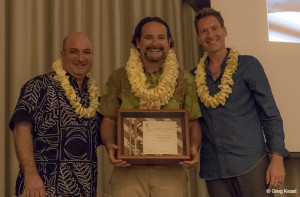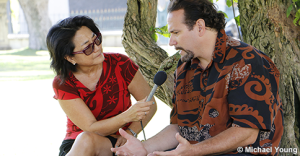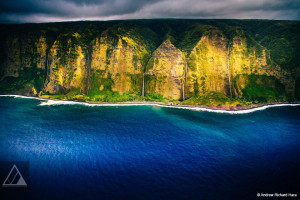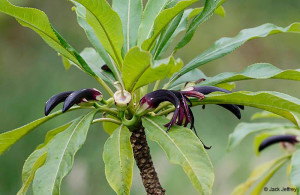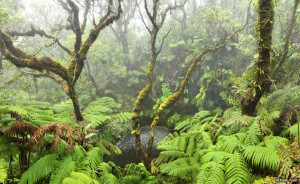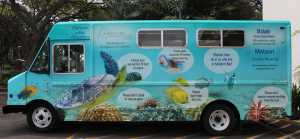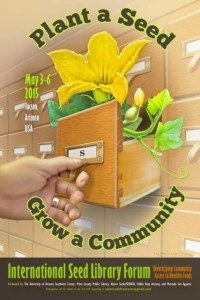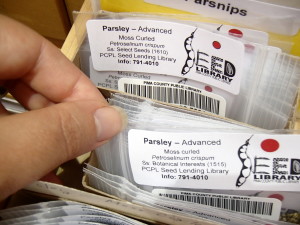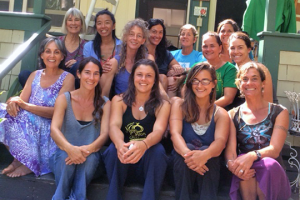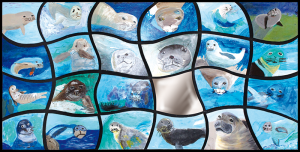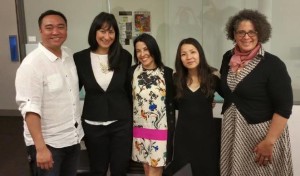IN THIS ISSUE:
Accolades for Kamana Beamer’s vision of “uniquely Hawaiian leadership”
Keawe Liu named vice president of advancement and innovation
Photography project to inspire reverence for native forests and water
Kahalu‘u Bay Education Center blesses new home
Hawai‘i represented at International Seed Libraries Forum
Program news
Accolades for Kamana Beamer’s vision of “uniquely Hawaiian leadership”
At this year’s Ka Palapala Po‘okela Awards in Honolulu, the Hawai‘i Book Publishers Association bestowed its highest honor—the Samuel M. Kamakau Book of the Year Award—to No Mākou ka Mana: Liberating the Nation, the first book written by our president and CEO, Dr. Kamanamaikalani Beamer. Beamer’s book, published by Kamehameha Publishing, also received an Honorable Mention in the Excellence in Nonfiction category and an Award of Excellence in the Excellence in Hawaiian Language, Culture & History category.
Dr. Kamanamaikalani Beamer (center) is joined by Ron Cox (left), director of Kamehameha Publishing, and David Deluca, president of the Hawai‘i Book Publishing Association, as he receives the 2015 Samuel M. Kamakau Book of the Year Award. (Photo courtesy Greg Keast)
Beamer describes No Mākou ka Mana as a story about the creative and amazing indigenous leadership in Hawai‘i in the 18th and 19th centuries. In an interview with the Hawai‘i Book Publishers Association immediately following the awards ceremony, Beamer characterized his book as “a story of hope and courage and resolve in how the native rulers engaged with the outside world in creative ways and embraced other people and cultures to form a bilingual country based around indigenous Hawaiian values and perspectives.” He attributes this “diplomatic prowess” and policy of diplomatic engagement to Hawaiian leaders who had a firm sense of who they were as Hawaiians in their changing world.
WATCH: Interview with the Hawai‘i Book Publishers Association, April 25, 2015
In an interview with Hawai‘i Public Radio’s Noe Tanigawa, Beamer spoke extensively about the historical characteristics of Hawaiian leadership and the thoughtful approaches that ali‘i (Hawaiian chiefs) employed to protect their subjects and the independence of the islands. In the face of threats from foreign governments in the 19th century, ali‘i recognized that, according to Beamer, “the only way to protect us from the potential of being colonized or carved up by another country [was] to achieve formal recognition as an independent and sovereign state.” Ali‘i were particularly strategic in developing diplomatic ties with the world’s most powerful nations and integrating Western political structures to cultivate a respected—yet uniquely Hawaiian—form of government.
“In a time where ‘might made right,’ tiny little islands that were not military equals to the powerful Great Britains and United States of Americas at the time…were [recognized as] legal equals,” Beamer said. In November 1843 the Kingdom of Hawai‘i became the first non-colonized, non-European sovereign state in the world; in the decades that followed more than a dozen nations across Europe, Asia, and the Pacific would sign treaties with the independent and sovereign Hawaiian Kingdom.
Beamer spoke with Hawai‘i Public Radio reporter Noe Tanigawa at ‘Iolani Palace to discuss his book and the historical and contemporary attributes of Hawaiian leadership. (Photo courtesy Michael Young/Kamehameha Schools)
Tanigawa observed that Hawaiian leadership of the 18th and 19th centuries was also characterized by a more nurturing, symbiotic relationship between ali‘i and maka‘āinana (commoners)—an ideology not often seen in elected leaders today. “In the Hawaiian context of words for leadership, one that always amazes me is this word ‘malu,’” Beamer said. “One of the meanings of malu is shade. If you’re a Hawaiian leader you provide shade for people, you provide an environment that helps them to thrive and gets them out of the heat and you make their lives a little easier. ‘Opu ali‘i’ is having the gut of a chief, someone that’s benevolent and gives of themselves and their resources, but also someone that is willing to stand up and to speak out and to risk maybe their own personal gain for the benefit of the collective. When’s the last time we looked at a representative in our government and thought, ‘wow, this person is really providing shade for the people?’”
Beamer completed No Mākou ka Mana in 2014 while still a professor in both the William S. Richardson School of Law and the Hawai‘inuiākea School of Hawaiian Knowledge at the University of Hawai‘i at Mānoa. A graduate of Kamehameha Schools in Honolulu, Beamer went on to receive bachelor’s degrees in Hawaiian studies and philosophy, as well as master’s and doctorate degrees in cultural geography from UH Mānoa. He was inspired to write the book while researching his doctoral thesis, and began developing his manuscript while a postdoctoral fellow in the inaugural cohort of our Mellon-Hawai‘i Doctoral and Postdoctoral Fellowship Program in 2008–2009.
“I started to study the land tenure system here in Hawai‘i and the deeper I got into it the more rigorous it was and the more ordered I recognized it to be—ordered in a very Hawaiian, place-specific way,” he said.
It was that knowledge of the Hawaiian land tenure system that led Beamer to read original documents and letters from rulers in the 18th and 19th centuries. These Hawaiian language sources and archival documents helped him frame an interpretation of the Kingdom’s history from the perspective of what Beamer calls “ʻŌiwi (Native Hawaiian) optics.”
“In the course of my research I started to realize that these leaders had never been portrayed in a light that showed how really intelligent and creative they were in the midst of challenges and tremendous change,” Beamer said, explaining that the book doesn’t focus on what missionaries did for or to Hawaiians but much more on what Hawaiians did for themselves. “We used ʻŌiwi optics to see how our leaders were viewing this engagement with the outside world from their perspective and in their terms.
“That was a really powerful thing for me because so much of that resonates with me as a Hawaiian in 2015. Indeed, much of the cultural reawakening and renaissance that’s happened since the 1970s has been trying to restore parts of our identity,” he said.
Beamer also noted a unique and essential characteristic of Hawaiian leadership in his conversation with Tanigawa: aloha. “Certainly aloha is a key part of Hawaiian leadership and something that we can never move away from. Aloha is powerful: it’s reciprocity, it’s love, it’s compassion, and a part of it is also wiwo‘ole or fearlessness. Having aloha and being able to stand up for what you believe in and speak out are key parts of Hawaiian leadership that you’ll find examples of in my book and in amazing leaders in Hawai‘i today.”
While No Mākou ka Mana examines the history of the Hawaiian Kingdom from a uniquely ʻŌiwi perspective and uncovers lessons that can benefit Hawai‘i’s future, the book does not have a particular agenda and is intended to appeal to a broad audience. “As someone who grew up in Hawai‘i in the 1950s and 60s, I found Kamana’s book to be profoundly eye-opening,” said Dr. Matthews Hamabata, The Kohala Center’s founding president and CEO and Beamer’s predecessor. “No Mākou ka Mana should be on everyone’s ‘must-read’ list regardless of where they stand in the spectrum of contemporary Hawaiian issues, as it offers an objective account of the endurance of indigenous values in a rapidly changing landscape. Kamana uses Hawaiian language archival research to uncover ancestral knowledge that will help island communities define paths to take, so that we can thrive ecologically, economically, culturally, and socially.”
Keawe Liu named vice president of advancement and innovation
Our fifteenth year continues to bear exciting changes and amazing new opportunities to serve island communities. To help lead us forward as we develop our new campus and plan for a sustainable future, we’re pleased to welcome Keawe Liu to our ‘ohana as our vice president of advancement and innovation.
Keawe Liu joins The Kohala Center as vice president of advancement and innovation on July 1.
Over the course of his 20-year career, Liu has established a successful track record in advancement, educational leadership, small business administration, and developing innovative partnerships and collaboration strategies to build collective support for community-based programs. He joins us after serving as the executive director of the Pauahi Foundation, where he was responsible for developing strategic initiatives for the advancement of Native Hawaiian education.
“Hawai‘i Island is a special place for me, and I’ve long admired The Kohala Center’s efforts to uphold it as an example of sustainable living—for Hawai‘i and the world,” Liu said. “I’m thrilled and honored to be part of the momentum The Kohala Center has already created and to play a role in developing new and innovative ways to further its progress, especially through the development of its spectacular new campus on Kohala Mountain. This opportunity to join The Center and contribute to expanding its community of support for resource management, education, and sustainability in agriculture and energy is one I simply could not pass up.”
Born in Honolulu and a longtime resident of Waimea on Hawai‘i Island, Liu previously served as the assistant headmaster for external relations at his alma mater, Hawai‘i Preparatory Academy, and as an instructor in Hawaiian history, Pacific studies, and mathematics. He also held positions as the head of institutional advancement, director of capital projects, and athletic director at Parker School. In 2011 Pacific Business News named Liu as its Young Community Leader of the Year, and also recognized him as one of Hawai‘i’s “40 under 40.” He holds a Bachelor of Arts degree in anthropology from the University of Colorado at Boulder and a Master of Education from the University of Hawai‘i at Mānoa.
Keawe joins our team at a most auspicious time in our organization’s history. Given his dedication to expanding educational opportunities for Hawai‘i’s youth and his focused leadership to move our islands toward greater food and energy independence, we see his interests and accomplishments as being in perfect alignment with our values. Welcome, Keawe!
Photography project to inspire reverence for native forests and water
Hawai‘i Island is a spectacular natural wonder for both scientists and visual artists, boasting pristine beaches, active volcanoes, barren lava flows, maritime deserts, soaring snow-capped mountains, and vibrant coral reefs. Through the lenses of three of Hawai‘i’s premier nature photographers, our latest project will lead ecology enthusiasts on a virtual journey to one of the island’s most unique and least accessible locations: the forests of Kohala Mountain.
Majestic cliffs and waterfalls—viewable only by air or by sea—grace the coastline around Kohala Mountain. (Photo courtesy Andrew Richard Hara)
“Images of Kohala: Source of Water, Source of Life,” coordinated through our Kohala Watershed Partnership (KWP), is a three-year project intended to inspire appreciation of native Hawaiian forests by documenting the flora, fauna, water, and atmospheres of Hawai‘i Island’s oldest and most ecologically diverse mountain. The George P. and Ida Tenney Castle Trust, administered by trustee Bank of Hawaii, has committed funding support for the program’s first year, with the option to fund up to two additional years.
Under the leadership of KWP coordinator Melora Purell, three professional “photographers-in-residence” will spend the first year accompanying the Partnership’s experienced field crew on day trips and extended camping expeditions into Kohala’s most extreme and rugged forests, streams, and wetlands. The project’s second year will focus on the publication of a book by University of Hawai‘i Press composed of the photographers’ work and observations, accompanied by place-based cultural narrative by our president and CEO, Dr. Kamanamaikalani Beamer, and ecological narrative by Purell. The photographers-in-residence will present public lectures and lead field trips for naturalists and other photographers in the community in the project’s second and third years, and a traveling photo exhibit will tour galleries on Hawai‘i Island, Maui, O‘ahu, and Kaua‘i in conjunction with the release of the book in mid-2017.
Endemic to Kohala Mountain and once thought extinct, ‘Oha wai (Clermontia kohalae) has beautiful dark purple flowers pollinated by native birds. (Photo courtesy Jack Jeffrey)
Cloud forests like those found on the slopes of Kohala Mountain host a disproportionate percentage of the planet’s rare and endemic—and increasingly vulnerable—species. “More than 90 percent of the plant and animal species found on Kohala are found nowhere else in the world, and the ever-increasing threats from invasive species, feral animals, and climate change have created a biodiversity crisis,” Purell said. “We must protect these species and their intact habitats now before they are lost forever.”
Natural and human communities on and around Kohala depend on the mountain to capture and store rainfall—our source of water and life. Not many people have the opportunity to visit a native forest or to understand firsthand the role a forest plays as their source of water. “Our goal is to connect the public with these remote places and inspire people of all ages and walks of life to cherish our native forests and work together to protect them,” Purell continued. “Our survival and that of our uniquely Hawaiian plants, birds, and other animals depends on it.”
Each of the photographers-in-residence brings extensive experience shooting in Hawai‘i’s wilderness environments and a demonstrated passion for environmental conservation to the project:
- Jack Jeffrey of Pepe‘ekeo, Hawai‘i Island, worked for over 20 years as a wildlife biologist at Hakalau National Wildlife Refuge, and has been photographing Hawai‘i’s native flora and fauna for over 40 years. As one of Hawai‘i’s foremost natural history photographers, he captures striking images of Hawai‘i’s native birds that have become the international standard for Hawaiian bird photography.
- Nate Yuen of ‘Ewa Beach, O‘ahu, is a hiking enthusiast who found a passion for photography as a result of wanting to document the minute details he would see on his expeditions. Much of his work focuses on the unique and rare plants and animals that live in Hawai‘i’s native habitats, many of which are barely visible to the naked eye.
- Andrew Richard Hara of Hilo specializes in capturing distinctive images of planet Earth. His photographs invite viewers to inhabit expansive, indescribable, often ethereal landscapes. He has worked with NASA, National Geographic, and TIME magazine, and his agency, ‘Ena Media Hawai‘i, recently became the first and only FAA-approved commercial drone operator in Hawai‘i.
Clouds envelop a native stream on Kohala Mountain in a fine gentle mist. ʻŌhiʻa trees draped in moss and a community of native ferns—hapuʻu, amaʻu, uluhe lau nui, and ‘ekaha—thrive in the mountain’s remote rainforests. (Photo courtesy Nate Yuen)
“Kohala Mountain’s rainforests have held a special place in my memories for 35 years,” said Jeffrey, who worked with the Hawai‘i Forest Bird Survey on the mountain in the late 1970s. “This project will take us and our audience to one of the most amazing, remote, and breathtaking places in the Hawaiian Islands. It’s not often that you get to work with renowned photographers and ecologists on a worthwhile project like this, and be able to share these visual moments with people from Hawai‘i and around the world. This is going to be an unbelievably rewarding experience.”
The photographers will post select images and observations as the project progresses on Facebook at facebook.com/ImagesOfKohala.
“For me, this project is an extension of my lifelong dedication to supporting progressive sciences and environmental conservation through visual communications,” said Hara. “I believe photography can empower our planet by raising awareness of how beautiful and fragile Earth is. This project represents me and my colleagues as creators, explorers, and devoted stewards of our shared planet.”
Kahalu‘u Bay Education Center blesses new home
Something big, bold, and beautiful has come ashore and established a commanding presence at Kahalu‘u Beach Park. Thanks to the support of hundreds of donors, businesses, volunteers, and community partners, our Kahalu‘u Bay Education Center (KBEC) has a new, bigger, and more modern home. The community welcomed the new center—a 25-foot-long mobile education unit—with a blessing and celebration on June 22.
WATCH: Danny and Anna Akaka bless the new mobile education unit
Kahalu‘u Bay Education Center’s new mobile education unit features significantly more storage space and a colorful vehicle wrap that educates visitors about “reef etiquette.”
The new mobile education unit, which replaces the original colorful van that served as the program’s headquarters since its official launch in 2011, provides an increase of more than 1,000 cubic feet of space for everything from snorkel gear and merchandise to educational materials. The additional capacity will enable the center to serve and educate even more visitors on how to enjoy Kahalu‘u Bay without harming its fragile corals.
“The bigger vehicle will allow us to serve and create lifetime memories for even more visitors,” said KBEC program director Cindi Punihaole. “We are so grateful to our longtime supporters, new friends, and visitors who contributed to this effort and made our beautiful new center a reality.”
The new vehicle was blessed by Danny Akaka (left) and his wife Anna (right). KBEC director Cindi Punihaole (center) led the successful fundraising effort to secure the new center.
Daily use and increased visitor traffic, coupled with Kahalu‘u’s abundant sunshine and salty air, had taken its toll on the original van, causing the little seven-day-a-week workhorse to literally burst at the seams. KBEC began its $60,000 fundraising efforts for the new vehicle in January 2014, and supporters quickly pledged $40,000 in matching funds. Within six months an additional $20,000 in pledges made the upgrade a reality. “No contribution was too small. We even had a tip jar at the center for visitors to donate their loose change and that ended up making a big difference. Truly every little bit helped,” said Punihaole, who led the fundraising effort.
(The faithful little van that served as KBEC’s original headquarters is, in a way, being “put out to pasture”: it’s currently enjoying its new home at our Demonstration Farm in Honoka‘a, from which it will transport fresh produce to our booth at the Waimea Midweek Farmers Market and our farm’s wholesale customers.)
Punihaole worked with the California office of FoodCart USA to procure the new vehicle, which had once served as a food truck in South Dakota. FoodCart USA brought the vehicle to Southern California to be inspected, repaired, painted, and the interior gutted and new walls installed. They also coordinated the installation of a colorful and educational vehicle wrap designed by Honoka‘a-based artist Jessica Young before the vehicle was shipped to Kawaihae courtesy of Matson Navigation. Upon its arrival in Hawai‘i, KBEC staff took to installing interior storage amenities, a flat-panel monitor for screenings of the center’s bay orientation video, and other finishing touches before the new center made its big debut.
Kahalu‘u Bay’s world-class snorkeling attracts more than 400,000 visitors each year, making the bay the most popular tourist destination on the west coast of Hawai‘i Island. KBEC staff and volunteers greet, educate, rent snorkel gear, and sell merchandise to 12,000 visitors a year at the center, and educate an additional 40,000 patrons annually on the beach and in the water about stewardship and “reef etiquette” through its ReefTeach volunteer program.
Members of The Kohala Center’s staff and ReefTeach volunteers pose in front of the new center at Kahalu‘u Beach Park.
Like all of our programs, KBEC evolved from the expressed needs and aspirations of local communities. In KBEC’s case, residents of Kahalu‘u grew concerned that the increasing number of visitors to the bay was adversely impacting the health of coral reefs and marine life due to beachgoers literally trampling the corals to death. The University of Hawai‘i Sea Grant Program helped the community establish the ReefTeach volunteer program in 2000 to educate bay visitors not to step or stand on corals, and in 2006 The Kohala Center was asked to assume management of the program. Five years later, we entered into a ten-year agreement with the County of Hawai‘i to establish KBEC with the goals of creating an education center to protect the bay’s fragile ecosystem and ensure that the bay and park remain a clean, safe, and welcoming place for both visitors and residents.
Moving forward, KBEC plans to embark on a fundraising campaign to develop a long-term plan that will improve Kahalu‘u Beach Park’s public facilities and establish a permanent education center.
“Keeping the bay healthy is critical not only to the communities surrounding Kahalu‘u, but the region’s economy as well, and we will continue to welcome the community’s support to keep Kahalu‘u a happy and healthy place,” Punihaole said. “Kahalu‘u Bay a vital environmental, cultural, and economic asset to our island. But our work doesn’t have just a local impact: we think of our visitors, who come to Kahalu‘u Bay from all over the world, as ambassadors who can carry our message home with them and make positive impacts on their local marine and aquatic environments. A quick interaction that promotes a behavior change as small and simple as not standing or stepping on coral can truly have a ripple effect across oceans and around the world.”
Hawai‘i represented at International Seed Libraries Forum
To celebrate and raise awareness of a growing global seed library movement, several organizations banded together to host the First International Seed Library Forum, which took place May 3–6 in Tucson, Arizona. Ilana Stout of our Hawai‘i Public Seed Initiative attended the Forum to learn from successful seed-lending libraries, share ideas, discuss legal and logistical challenges, and bring home knowledge that could guide the creation of seed libraries in Hawai‘i in the future.
Poster for the First Annual International Seed Library Forum held in Tucson, Arizona.
Over the last ten years, communities around the world have realized an innovative and accessible way to share seeds: public seed libraries. Often located in public libraries, seed libraries offer a variety of seeds that the public can “check out” and grow in their home gardens. Patrons who successfully grow varieties to seed can then donate seeds back to the seed library, where they are screened, packaged, and added to the catalog. Because seed libraries are curated, centrally located collections, they have distinct advantages over traditional seed exchanges, including increased availability to the public and improved control over the possible spread of invasive species. The seed library model has become so popular that there are now more than 400 established seed library projects around the world.
In just the past year, however, seed libraries in five states in the U.S. have encountered challenges from their departments of agriculture, which have requested that the libraries comply with regulations designed for commercial seed houses. These include large-scale germination testing and destroying all seed at the end of the calendar year—two measures that are unrealistic for small-scale seed libraries that rely largely on donations and are designed for the use of home gardeners rather than commercial farmers. The Sustainable Economies Law Center has been working with seed libraries and state legislators to ensure that state seed laws are being applied appropriately and, where necessary, to introduce new legislation that protects the right to save and share non-patented agricultural seeds.
The event opened with a seed exchange and screening of the film “Seeds of Time,” which discusses genetic erosion in the food supply and the process of establishing the Svalbard Global Seed Vault. Workshops and panels were hosted by the Pima County (Arizona) Public Library, which has eight well-established seed libraries across the county and has so far checked out more than 20,000 packets of fruit and vegetable seeds in 2015 alone.
A customer peruses a sampling of available seeds at the Pima County (Arizona) Public Library’s seed library.
Workshop topics included Establishing Best Practices for Seed Library Management, Collecting and Documenting Oral Histories of Heirloom Varieties, Addressing Regulatory Challenges, The Role of Seed Libraries in School Gardens, and many more. The four-day event included field trips to local food and agriculture-related organizations, a literary reading, and a tamale dinner in celebration of maize diversity.
“Attending this conference representing The Kohala Center and our Hawai‘i Public Seed Initiative was an amazing opportunity to connect with people active in the seed-saving movement, many of whom I cited in my master’s research proposal,” Stout said. “The event gave me a chance to discuss some of the unique challenges for seed saving and sharing in Hawai‘i, as well as brainstorm possible solutions and paths forward.”
Our Hawai‘i Public Seed Initiative is currently looking into establishing a centrally located, curated seed library in East Hawai‘i and working closely with members of both the conservation and agriculture communities to ensure that the project is successful in increasing public access to seed while protecting and preserving native ecosystems. If you would like to contribute to this process by helping to design protocols, identifying possible locations, developing educational materials, packaging seeds, or in other ways, please contact Ilana Stout at istout@kohalacenter.org.
Program news
We turn research and ancestral knowledge into action, so that communities in Hawai‘i and around the world can thrive—ecologically, economically, culturally, and socially. We accomplish this through a suite of community-based programs—‘āina-based programs for community well-being. Here we share what our programs have been up to and highlight upcoming opportunities.
- After seven years of lobbying and advocacy by community groups including our Hawai‘i Island School Garden Network and Hawai‘i Farm to School and School Garden Hui, the Hawai‘i State Legislature has appropriated funds for the creation of a Hawai‘i farm to school program and a full-time farm to school coordinator position at the Hawai‘i Department of Agriculture. Senate Bill 376 seeks to improve the health and well-being of Hawai‘i’s schoolchildren by promoting school garden programs, health and nutrition education, agriculture, and increasing the amount of locally produced foods for school meals and snacks. The bill was also supported by the Local Food Coalition, the University of Hawai‘i at Mānoa College of Tropical Agriculture and Human Resources, the Hawai‘i Farm Bureau, Kōkua Hawai‘i Foundation, the Office of Hawaiian Affairs, the National Farm to School Network, and many Hawai‘i farmers, teachers, parents, and schoolchildren themselves.
- Select school learning garden and sustainability educators from Hawai‘i Island and O‘ahu convened in Waimea for an eight-day working session to begin developing curriculum that aligns garden education programs with core standards. The curriculum will provide Hawai‘i schools with options for dynamic, hands-on, garden-based lessons and activities intended to help students connect with core standards in practical and meaningful ways. The working group will convene again in late August and work through the fall and spring to match activities with standards by grade and refine content, with an eye toward rolling out curriculum and offering workshops in the summer of 2016.
- Our Hawai‘i Public Seed Initiative recently awarded $18,614 in mini-grants to ten farmers and organizations on Hawai‘i Island, Maui, O‘ahu, Moloka‘i, and Kaua‘i. The mini-grants, made possible with support from the Ceres Trust, further local projects in the areas of community-building, education, seed-saving, variety trials, and procurement of equipment. Click here to view the list of 2015 mini-grant recipients and their projects.
- While helping to reorganize the West Hawai‘i Marine Mammal Response Network, our Kahalu‘u Bay Education Center team had the opportunity to educate fourth graders at Kahakai Elementary School about the plight of critically endangered Hawaiian monk seals. Turning their new knowledge into action, the keiki created the beautiful mural at right along with an inspiring book of poetry. The public is invited to see the mural in person at the Mokupāpapa Discovery Center in Hilo. Mahalo to the National Oceanic and Atmospheric Administration and Kona Trans for their support.
-
The Kohala Watershed Partnership (KWP) crew, including six summer interns, are continuing to re-survey the containment zone for Rauvolfia vomitoria. North Kohala is currently the only place on the planet in which this noxious tree from tropical Africa is invasive. Through control “sweeps” covering 6,000 acres over the past three years, KWP has contained its spread and kept it from invading native forests on Kohala Mountain.
-
This summer the KWP crew will also be working at the Waimanu Bog Plateau doing invasive ginger control, and building two miles of conservation fences at Laupāhoehoe Nui. The only way that KWP’s field crew can access these and other work sites on windward Kohala is via helicopter, which not only transports the team but also their tools, equipment, and camping gear.
- Congratulations to current Mellon-Hawai‘i doctoral fellow Liza Keānuenueokalani Williams (second from left), who successfully defended her dissertation at New York University in May. Williams’ research focused on the ways that tourism, the military, and the prison industrial complex shape cultural politics for Kānaka Maoli both historically and in the contemporary moment. She is the twelfth Native Hawaiian doctoral candidate in our Mellon-Hawai‘i Doctoral and Postdoctoral Fellowship Program to complete her Ph.D.
- Hawai‘i Island farmers and food producers are invited to participate in a “Meet Your Farmer Mixer” hosted by The Kohala Center and the Arts & Sciences Center on Tuesday, June 30 from 3 to 4:30 p.m. at the Hawai‘i Academy of Arts and Science in Pāhoa. The event will connect Hawai‘i Island farmers, food producers, and distributors with public charter school administrators and food service personnel seeking to increase the availability of fresh, locally produced food in their schools. By making the farm to school connection, island food producers can increase their customer bases and earnings while providing a healthier future for our keiki and communities. There is no fee to attend. Register by June 26 at koha.la/f2smixer or call 808-887-6411.
- Our Beginning Farmer-Rancher Development Program recently graduated 15 students from its fourth cohort, bringing the total number of new Hawai‘i Island farmers trained through this program to 56.
- Family ranchers on Hawai‘i Island will soon be able to access an additional slaughter option through a new mobile slaughter unit for cattle, sheep, goats, and pigs beginning in 2016. In the works for years, the cooperative endeavor recently moved from concept to reality thanks to a partnership with the Hawai‘i Department of Agriculture. Informational sessions for those interested in learning more about the service will be held in Kainaliu on Sunday, July 12 and Waimea on Sunday, August 9. For more information visit the Hawai‘i Island Meat website or email HawaiiIslandMeat@gmail.com.


